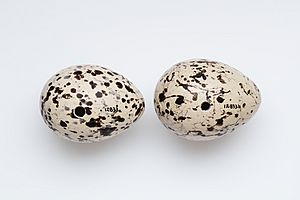Chatham oystercatcher facts for kids
Quick facts for kids Chatham oystercatcher |
|
|---|---|
| Conservation status | |
 Nationally Critical (NZ TCS) |
|
| Scientific classification | |
| Genus: |
Haematopus
|
| Species: |
chathamensis
|
The Chatham oystercatcher (Haematopus chathamensis) is a special type of oystercatcher. It is a wading bird that lives only on the Chatham Islands in New Zealand. This bird is considered endangered. In 2004, there were only about 310 to 325 of these birds left. The biggest danger to them comes from animals that were brought to the islands by people.
What They Look Like
The Chatham oystercatcher has striking black and white feathers. It has a long, thick beak that is orange-red. Its head, neck, chest, back, wings, and tail are black. The lower part of its body is white. Its eyes are yellow, and they have orange rings around them. The bird's short, thick legs are pink. Adult Chatham oystercatchers are about 48 centimetres (19 in) long.
Where They Live
The Chatham oystercatcher is found only on the Chatham Islands. This group of islands is about 680 kilometres (420 mi) southeast of New Zealand. Each of the four main islands has small groups of these birds that breed there.
How They Live

Chatham oystercatchers eat molluscs, like shellfish, and marine worms. They dig these foods out of the sand with their beaks. They can also hammer open shells to get to the food inside. They prefer to find food on rocky shores and sandy beaches. Some birds even look for food in grassy areas.
They build their nests on the beach, either on sand or rocks. A nest is usually a simple scrape in the ground. Sometimes, it might be a bit more detailed if built among small plants. They usually lay two or three eggs. Young birds leave their birth area about 33 days after they learn to fly. These birds become adults and can have their own babies when they are about three years old. They usually live for about eight years. Many eggs are lost because of flooding.
Why They Need Our Help
In the late 1980s, there were fewer than 110 Chatham oystercatchers. People worried their numbers were still going down. By 2006, there were an estimated 310 to 360 birds on the Chatham Islands. Less than 250 of these were adult birds. The population is now thought to be stable.
The IUCN says the Chatham oystercatcher is "Endangered". New Zealand's Department of Conservation calls it "Nationally Critical." The main dangers to these birds are animals that hunt them. Feral cats often eat their eggs and chicks. Cattle and sheep that walk onto the beaches can accidentally step on nests. The flightless weka (Gallirallus australis) also eats their eggs.
See also
 In Spanish: Haematopus chathamensis para niños
In Spanish: Haematopus chathamensis para niños


